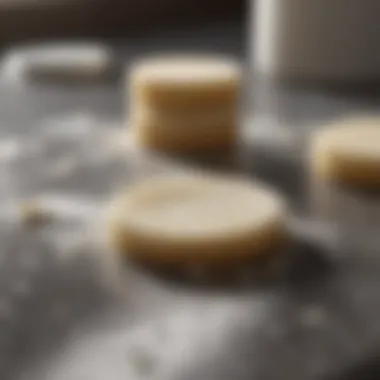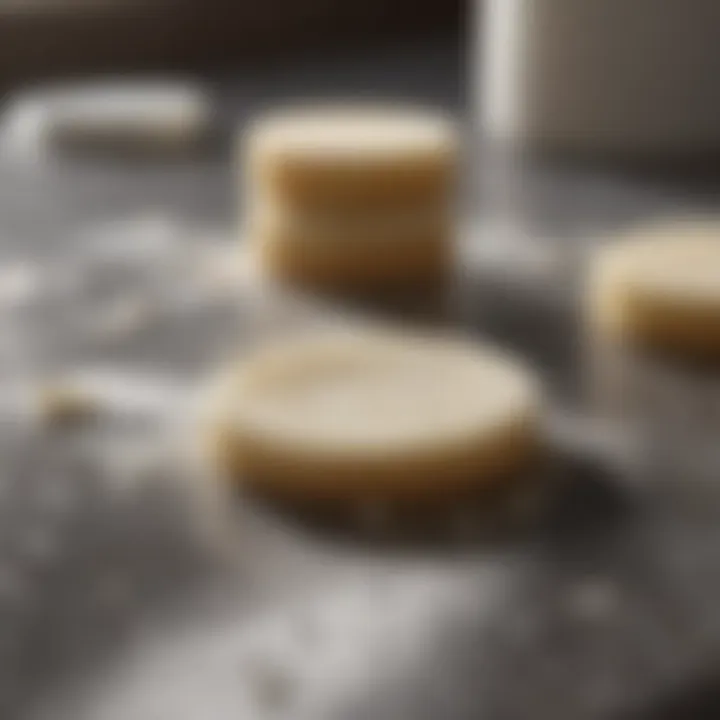Essential Kitchen Cleaning Tools for Efficient Cooking


Intro
In a world where kitchens are often deemed the heart of the home, maintaining cleanliness is crucial. The kitchen is not just a place for cooking; it is where gatherings happen, where families connect, and where culinary creativity is expressive. However, with all the food preparation, spills, and daily use, a pristine atmosphere requires diligent upkeep. This article delves into the core tools that are indispensable for effective kitchen cleaning.
Understanding the right cleaning tools can significantly enhance both efficiency and effectiveness. With various categories of items available—from scrub brushes to absorbent cloths—knowing their purposes and best practices is essential. In this guide, we will explore tools that serve specific functions, their benefits, and insights on sustainable cleaning practices. This information is valuable not just for novice cooks but for seasoned chefs hoping to keep their kitchens spotless.
Moreover, the selection of cleaning tools can prevent cross-contamination and promote a sanitary cooking area. Grasping these essentials helps in cultivating a hygienic environment while also saving time and energy. By the end of this article, readers will be equipped with the knowledge necessary to make informed choices about kitchen cleaning tools.
Understanding Kitchen Cleaning Tools
Cleaning is an essential part of maintaining a healthy kitchen. Kitchen cleaning tools play a vital role in this process. They ensure that surfaces are free from dirt, bacteria, and grime, which can lead to foodborne illnesses. Knowledge of cleaning tools can enhance efficiency while reducing effort and time spent on chores.
Proper selection of cleaning tools can make the cleaning process more effective. Factors like the type of surfaces being cleaned and the kind of stains or messes encountered matter greatly. Investing in high-quality tools that suit your specific needs not only leads to better results but also prolongs the life of your kitchen surfaces. Moreover, using the right tools promotes a sense of organization and cleanliness, which aids in creating a pleasant cooking environment.
Defining the Importance of Cleaning Tools
Cleaning tools are more than just instruments; they are the backbone of a hygienic kitchen. They help streamline the task of cleaning by having specialized capabilities. For example, certain sponges are designed to tackle tough stains, while microfiber cloths excel at picking up smaller particles and dust. The right cleaning tool makes it possible to reach difficult spots, ensuring that all areas receive attention without excessive effort.
A well-maintained kitchen ultimately reflects the owner's care for food safety and hygiene. It creates an inviting space, whether for family or guests. Keeping surfaces clean reduces the risk of cross-contamination, which is crucial for health. Thus, understanding cleaning tools is essential for those who cook regularly, as it guarantees that their culinary space remains safe and pleasant.
Types of Cleaning Tools
There a variety of cleaning tools available, each serving a specific purpose.
- Absorbent Materials: Microfiber cloths and paper towels are commonly used for quick cleanup. They trap moisture and dirt, helping to maintain surface integrity.
- Scrubbers: Sponges and abrasive scrubbers are used for more tough messes. They are excellent for removing food residues or stains stuck on pots or pans.
- Specialized Tools: Certain areas, like ovens and dishwashers, require specific cleaners to address grease and grime effectively. These tools enhance performance and ensure thorough cleaning.
When investing in cleaning tools, it's essential to consider the materials and design. Each tool should cater to the unique challenges present in a kitchen, making cleaning simpler and more effective.
Essential Tools for Surface Cleaning
The kitchen is a central space in most homes, and keeping it clean is essential for healthy cooking and dining. Surface cleaning tools play a critical role in maintaining hygiene and organization in this area. They help to swiftly remove debris, spills, and stains from various surfaces, ensuring a tidy environment. This section discusses essential tools that every kitchen should have. By understanding their functions and benefits, individuals can choose which ones best suit their cleaning needs.
Microfiber Cloths
Microfiber cloths are one of the most efficient kitchen cleaning tools available. Made from synthetic fibers, they are designed to capture and hold dust, grease, and dirt effectively. The unique weave of microfibers allows these cloths to absorb water and clean surfaces without the need for chemical cleaners. This makes them an ideal choice for those looking to maintain a greener cleaning routine.
Key benefits include:
- Versatility: Microfiber cloths can be used on multiple surfaces like countertops, appliances, and even glass.
- Absorbency: They can hold up to seven times their weight in water, making them excellent for spills.
- Durability: With proper care, microfiber cloths can last for years, reducing waste and the need for repeated purchases.
Sponges and Scrubbers
Another essential tool for surface cleaning is sponges and scrubbers. Both are designed to work on different types of stains and messes found in a kitchen. Sponges are soft and absorbent, making them suitable for wiping surfaces and cleaning delicate items. In contrast, scrubbers have a rough texture that is effective for tackling tougher stains and baked-on messes.
Some important aspects to consider are:
- Material: Natural sponges are biodegradable, while synthetic sponges can last longer but may not be environmentally friendly.
- Variety: Some sponges offer dual-sided features—one side for scrubbing and the other for delicate cleaning.
- Sanitizing: Regular sanitization of sponges is necessary to avoid the buildup of bacteria, which can negate their cleaning efficiency.


Using specific sponges and scrubbers based on the cleaning task can make the process more effective while ensuring that various surfaces are cared for appropriately.
Paper Towels
Paper towels are a staple in many kitchens and serve several purposes. They provide a quick and convenient option for cleaning messes and wiping surfaces. Their disposable nature makes them practical for tasks that involve raw food items, spills, or other messes that require immediate cleanup.
Important considerations include:
- Absorbency: High-quality paper towels can absorb spills effectively without tearing.
- Convenience: They are readily available and easy to use, allowing for a quick cleanup process.
- Cost: Frequent use can lead to increased expenses, so it's essential to balance their usage with other reusable options.
Despite their convenience, relying solely on paper towels can lead to waste, making it prudent to complement their use with more sustainable tools like microfiber cloths or washable rags. Understanding the context in which to use each surface cleaning tool can enhance kitchen cleanliness and efficiency.
Deep Cleaning Tools
Deep cleaning tools are fundamental in maintaining a kitchen that is not only clean but also hygienic. These tools help remove grime and bacteria that regular surface cleaning might miss. Investing in the right deep cleaning tools can significantly enhance your overall kitchen cleaning experience and ensure your environment is safe for food preparation.
When you think about deep cleaning, consider it as the comprehensive approach to cleanliness that reaches beyond everyday dusting and wiping. It involves targeted actions intended to cleanse areas often neglected. This is especially important for a kitchen, where food is prepared and consumed. Regular deep cleaning can prevent the buildup of harmful bacteria and allergens. Moreover, these tools are designed for specific tasks, making them efficient and effective.
Floor Mops and Brooms
Floor mops and brooms are crucial for maintaining a clean kitchen floor. These tools are vital as they help collect dirt, dust, and debris that accumulates over time. A broom is often the first step in the cleaning process, allowing you to sweep up larger particles easily.
Once the bigger debris is gone, a mop can tackle spills, stains, and sticky substances. Mops have different materials, ranging from traditional cotton to modern microfiber. Each material has its benefits. Microfiber mops attract dust and grime more effectively, while cotton mops are known for their absorbency. It is wise to choose the one that fits your cleaning style and kitchen conditions.
Vacuum Cleaners
Vacuum cleaners are an often-overlooked tool in kitchen cleaning, yet they provide several advantages. They excel in managing crumbs and small particles that can attract pests and create health concerns. Some models come with attachments designed specifically for hard floors, ensuring you do not miss any hidden dirt.
Additionally, using a vacuum cleaner may reduce the time you spend on the overall cleaning process. Unlike traditional sweeping and mopping, vacuuming can facilitate both dry and wet cleaning in some models. Look for a vacuum that fits your needs, whether it’s bagless for easy disposal or one that can manage pet hair if your kitchen involves furry friends.
Steam Cleaners
Steam cleaners represent an innovative approach to deep cleaning. By utilizing high-temperature steam, these devices can sanitize surfaces and rid them of grease and grime without the need for harsh chemicals. This method can be especially beneficial in kitchens, where cleanliness is paramount for food safety.
Many steam cleaners come with various attachments, allowing you to clean multiple surfaces effectively, including tiles and carpets. Furthermore, since they rely on the intense heat of steam, they can often remove even stubborn stains and kill bacteria effectively.
With the right tools, deep cleaning becomes less of a chore and more of a systematic process to enhance your culinary experience.
Specialized Cleaning Tools
Specialized cleaning tools play a crucial role in enhancing efficiency during kitchen cleaning. These tools are designed for specific tasks, providing better results than general-purpose items. Their importance cannot be understated, as they help maintain a hygienic cooking environment effortlessly. Understanding each tool's benefits and appropriate usage can significantly affect the cleanliness of your kitchen.
Oven Cleaners and Brushes
Oven cleaners and brushes are essential for tackling the tough grease and grime that can accumulate in your oven. Regular cleaning prevents the build-up of residues which can affect food taste and hygiene.
Most oven cleaners come in spray or gel form, specifically formulated to cut through carbon and burnt food. When using these products, it's important to follow the manufacturer's instructions carefully. Wearing gloves is also advisable to protect your skin.


In addition to cleaners, specialized brushes provide targeted scrubbing for a thorough clean. They can reach tight spots and corners, helping maintain the oven's pristine condition. Some might prefer a natural cleaner such as a vinegar and baking soda mixture, as it can be effective and eco-friendly. Utilize these tools to keep your oven functioning properly and to extend its lifespan.
Dishwashers
Dishwashers are more than just time-saving devices; they can also be seen as specialized cleaning tools. Using a dishwasher effectively not only saves water but ensures proper sanitation of dishes. They offer high temperatures that eliminate bacteria which hand washing may fail to do.
It is crucial to choose the right detergent for your dishwasher. Many options are available, including powders, pods, and liquid forms. Understanding the differences in these products can lead to better results.
Regular maintenance of your dishwasher is also necessary. Occasional cleaning with a commercial dishwasher cleaner helps prevent buildup in the filters and spray arms. This will ensure that your dishwasher operates at peak efficiency, providing you with the clean dishes you desire.
Garbage Disposal Cleaners
Garbage disposal cleaners keep your disposal unit odor-free and functioning effectively. Food scraps can sometimes lead to unpleasant smells and blockages, making regular cleaning necessary.
These cleaners usually come in forms like powders or liquid solutions. They break down organic waste and eliminate the buildup of grease and food particles. It is essential to follow the instructions on the product to ensure safe and effective use.
Some users prefer homemade solutions, such as using ice cubes and citrus peels. Ice can help dislodge debris, while citrus peels not only freshen the smell but also help clean the blades. Regular cleaning extends the life of garbage disposals and maintains a pleasant kitchen environment.
Choosing Eco-Friendly Cleaning Tools
In contemporary society, the importance of eco-friendly cleaning tools cannot be overstated. Not only do they contribute to a cleaner kitchen, but they also promote a healthier environment. As awareness about environmental conservation increases, choosing sustainable cleaning options has become a priority for many consumers. This section will discuss the crucial aspects of selecting eco-friendly cleaning tools, emphasizing their benefits, materials, and effective alternatives.
Benefits of Eco-Friendly Products
One of the most significant advantages of eco-friendly cleaning products is their reduced impact on the environment. Many traditional cleaning products contain harsh chemicals that can harm the planet. Conversely, eco-friendly options are often made from natural ingredients that break down more easily in the environment. This means less pollution and a lower risk of contaminating soil and waterways.
Additionally, using these products can improve indoor air quality. Harsh chemicals found in conventional cleaning supplies can release volatile organic compounds (VOCs) that lead to respiratory issues and allergies. By opting for eco-friendly cleaning tools, consumers often experience better air quality within their homes. Furthermore, these products are usually safer for families and pets, minimizing the risk of chemical exposure, which is a crucial consideration for many households.
Biodegradable Materials
The term biodegradable refers to materials that can be broken down by natural processes. Choosing cleaning tools made from biodegradable materials is a vital step towards sustainability. When these materials are discarded, they decompose naturally, contributing to a decrease in landfill waste.
Some common biodegradable cleaning products are sponges, cloths, and brushes made from natural fibers. For instance, coconut coir fiber or bamboo are excellent options for sponges and scrubbers. These materials can break down over time, unlike traditional synthetic sponges that can take hundreds of years to decompose. Moreover, selecting items made from biodegradable materials can support a circular economy that minimizes waste impact.
Chemical-Free Alternatives
Another essential aspect of choosing eco-friendly cleaning tools is opting for chemical-free alternatives. Many brands now provide cleaning solutions that are free of artificial fragrances, colors, and synthetic chemicals. These products rely on natural components, such as vinegar, baking soda, and essential oils, to deliver effective cleaning without harmful side effects.
Using chemical-free products can yield impressive cleaning results while maintaining safety. For example, a mixture of baking soda and vinegar can effectively clean surfaces without damaging them. This not only protects the environment but also ensures a healthier cleaning experience. As awareness of the benefits of natural cleaning agents grows, more and more people are adopting these alternatives, leading to significant shifts in consumer behavior.
Eco-friendly cleaning tools are not just a trend; they are a necessity in achieving a sustainable future. By utilizing biodegradable and chemical-free products, consumers can actively contribute to environmental protection while maintaining home hygiene.
Purchasing Considerations
When it comes to selecting kitchen cleaning tools, purchasing considerations play a crucial role in determining your investment's effectiveness. Choosing the right tools not only enhances cleaning efficiency but also impacts the longevity of your orking area. To make informed choices, it is essential to focus on several key elements: material durability, cost efficiency, and brand comparisons.
Material Durability


Material durability is vital when assessing kitchen cleaning tools. Strong materials withstand frequent use, ultimately reducing the need for replacements. Using durable items like high-quality scrubbers or microfibre cloths can save money in the long run. Consider tools made of robust plastics, natural fibers, or stainless steel.
Incorporating durable materials into your kitchen arsenal can enhance your cleaning routine. For instance, microfiber cloths can last for hundreds of washes when properly maintained, continuously delivering the necessary cleaning power.
Cost Efficiency
Cost efficiency involves evaluating the overall value of your cleaning tools. While some products might have a lower upfront cost, investing in higher-quality tools may lead to savings over time. Assess the frequency of use and quality of each tool before a purchase. Tools that perform well and last longer reduce the need for constant replacements and excessive spending.
Additionally, consider bulk purchasing options. For example, buying packs of sponges or cleaning wipes can result in significant discounts, making them an economical choice for household cleaning.
Brand Comparisons
Brand comparisons are essential in identifying the best products in the market. Not all brands offer the same level of quality and performance. Research different brands and read reviews from other users. Recommendations from platforms such as Reddit or product reviews can offer insight into the advantages and drawbacks of specific brands.
Some well-known brands that focus on kitchen cleaning tools include OXO, Scotch-Brite, and Mrs. Meyer's. Each brand has its own range of products with varying features, price points, and user satisfaction levels. Explore these options to find suitable tools meeting your needs and budget.
Remember that better quality usually translates into better performance.
To conclude, understanding purchasing considerations is crucial when selecting kitchen cleaning tools. Focusing on material durability, cost efficiency, and brand comparisons helps in making choices that elevate your kitchen cleaning routine. Buying the right tools can lead to significant time savings and a cleaner cooking environment.
Maintenance of Cleaning Tools
Maintaining cleaning tools is a crucial aspect of an effective kitchen cleaning routine. Tools that are kept in good condition work better and last longer. Proper maintenance ensures efficient cleaning and helps in achieving hygiene standards in the kitchen. Well-maintained tools save money and time, reducing the need for frequent replacements. This section will cover proper cleaning techniques, storage recommendations, and recommended timelines for replacement.
Proper Cleaning Techniques
Using the right cleaning techniques for your tools is fundamental. Different materials require specific methods for preservation. For example, microfiber cloths can be washed in a machine, but should not be mixed with fabric softeners as these can lessen their effectiveness. It is also important to rinse sponges thoroughly after use to remove food particles and bacteria. Always allow them to dry completely before storing them to avoid mildew growth.
Another key method involves using disinfectants. Properly sanitizing tools, especially those in contact with raw food, is vital. This can be done using a solution of water and vinegar, or store-bought disinfectants. The cleaning method not only prolongs the tool's life but also maintains a sanitary environment.
Storage Recommendations
Storing cleaning tools properly protects them from damage and keeps them organized. Some tools, like mops and brooms, should be stored upright to prevent bending or warping. A dedicated space in a pantry or closet can help keep them out of reach of children and pets. For sponges and cloths, it is best to have a dry storage area. Hanging storage may be beneficial for certain tools to ensure air circulation.
Consider using baskets or containers to categorize cleaning supplies. Labeling can help quick retrieval and ensure that everything is where it belongs. This not only aids in maintaining the items but also optimizes efficiency in the cleaning process.
Replacement Timelines
Keeping track of when to replace cleaning tools is vital. Some tools have a limited lifespan. For instance, sponges should typically be replaced every 2-4 weeks, depending on usage. Microfiber cloths can last several years if cared for properly but should be discarded once they start to lose their absorbency or structure.
It is wise to create a replacement schedule for tools. Documenting when a tool was acquired can aid in determining when to replace it. Factors affecting replacement include extent of wear and efficiency. A general rule is, if a tool no longer performs effectively, it is time for a new one.
Regular maintenance and timely replacements enhance the longevity of kitchen cleaning tools, making the cleaning process more efficient.
Implementing these maintenance strategies will ensure that your cleaning tools function optimally, contributing to a clean and sanitary kitchen environment. Keeping tools organized and well-maintained is an investment in time and resources, ultimately improving the quality and effectiveness of your cleaning routine.
End
In the journey of maintaining a clean kitchen, the tools available have a significant impact. This article has outlined the critical aspects of selecting the right kitchen cleaning tools. Each section emphasized different categories of tools and their respective uses, ensuring the reader understands the importance of effective cleaning strategies. By employing the right tools, users not only enhance hygiene but also efficiency in their routines.
Summary of Key Points
- Understanding Tools: Recognizing the importance of kitchen cleaning tools is the first step. Effective cleaning starts with the right implements.
- Essential Surface Tools: Microfiber cloths, sponges, and paper towels are pivotal for everyday surface cleaning tasks, ensuring that spills and messes are dealt with promptly.
- Deep Cleaning Equipment: Tools like mops, vacuum cleaners, and steam cleaners are necessary for thorough cleaning, preserving the condition of floors and countertops.
- Specialized Options: Utilizing oven cleaners and effective garbage disposal cleaners can target specific problem areas often neglected.
- Eco-Friendly Choices: Opting for eco-friendly cleaning tools can benefit both the environment and your health, making it an essential consideration for modern households.
- Maintenance: Proper care and storage of cleaning tools prolong their lifespan, ensuring they remain effective and reliable when needed.
- Purchasing Tips: Evaluating durability, cost efficiency, and brand reputation can guide informed purchasing decisions, enhancing the overall cleaning experience.
By synthesizing these points, the article aims to equip readers, whether novice or experienced, with the necessary knowledge to optimize their kitchen cleaning routine. A clean kitchen not only promotes health but also reflects one’s care for the space where food is prepared and enjoyed.







